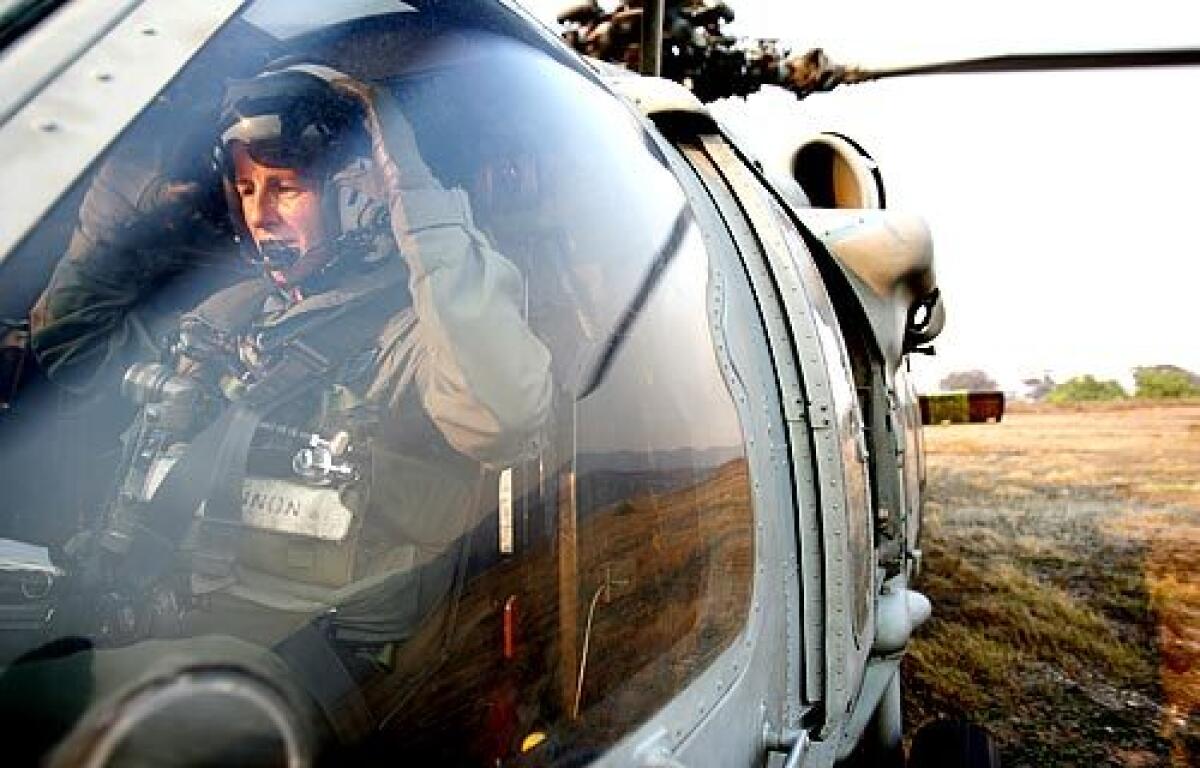A Navy chopper crew tackles a wildfire

- Share via
Spitfire flames jumped from the top of one brittle tree to the next. The mission, maybe impossible, was to save a neighborhood of leafy, curving streets just 300 yards up a small hill.
“This was the first big experience I’ve had fighting fires,” said Lt. Cmdr. Jen Hannon, copilot of a Navy helicopter who usually shuttles supplies but was dispatched with her craft and crew to fly daylight missions, dumping 420-gallon buckets of water on the Harris fire as it approached Bonita in San Diego County. “There was a lot of dense smoke -- so thick that we could taste it, as a matter of fact.”
Sweat formed small rivers down her face. Heat made the air thin and turbulent. Pilot Randy Borges struggled to make steady turns as the helicopter rocked and jumped. The whir of the rotors made it sound as if the four-member crew were inside a dentist’s suction tube.
“Our main mission was to keep the fire from jumping over a road and blazing up the hill to hit the houses on the top,” she said.
When the Navy helicopter arrived Tuesday morning, others from the California Department of Forestry and Fire Protection were already dumping water from a neighboring reservoir on the fire, apparently to no avail. They flew an oval pattern, dipping into the reservoir at one end, dropping their load at the other.
“Once we got our buckets loaded and dipped with water, we joined in with their daisy chain and flew the racetrack pattern with them, dipping and then dropping the water and coming around on the same turn,” Hannon said.
Still the fire grew, with no help available on the ground.
“We thought it was fruitless. We thought it was a hopeless cause,” Hannon said.
Somehow, the flames never reached the hill. By Wednesday morning when they returned, the fire had died down dramatically, but sections still smoldered.
Arriving from nearby North Island Naval Air Station, the helicopter hovered 100 feet over the glistening reservoir as the homes stood untouched to the left of the canyon. To the right, the charred hills looked as though they had been covered with asphalt overnight.
Hannon and her crew repeated the racetrack movement in hopes of killing the fire completely. The two crewmen in the back peered from the chopper’s open side down at the bucket, which hung from a bar spanning a hole in the middle of the cabin. They pushed a button to empty the bucket’s bladder.
They repeated the pattern for hours, bantering through their headsets to pass the time. The lone person underneath was a border agent in his pickup truck watching for illegal immigrants crossing from the border just over the hill.
“Your turns are nice and easy today,” Hannon teased her pilot. “So smooth that you almost fly like a girl.”
Borges laughed.
Hannon, who coordinated the mission, called for small adjustments as time moved on.
“We may be causing more harm than good. See how you are stirring up the smoke?” Hannon said.
Borges increased his altitude slightly for the next drop.
“There you go. There’s our Gorgeous Borges,” Hannon teased.
By the end of the day, they were optimistic that the stand on this corner of the Harris fire had been successful. The thick, black smoke of Tuesday had been replaced with a haze that painted the sun orange over the reservoir.
“I would absolutely volunteer again to fight the fires,” Hannon said. “It’s not necessarily the most fun flying I have ever done, but, by far, hands down, it is the most rewarding.”
More to Read
Sign up for Essential California
The most important California stories and recommendations in your inbox every morning.
You may occasionally receive promotional content from the Los Angeles Times.










